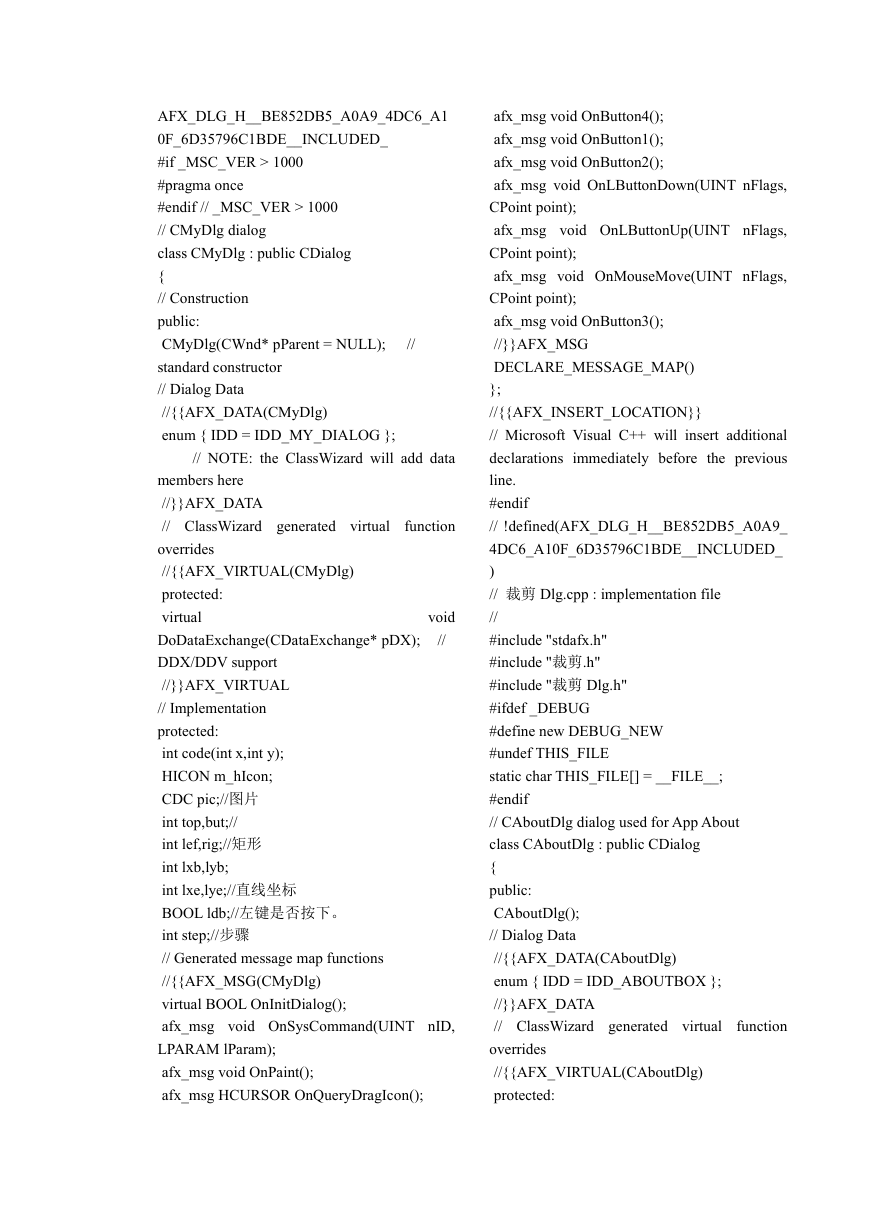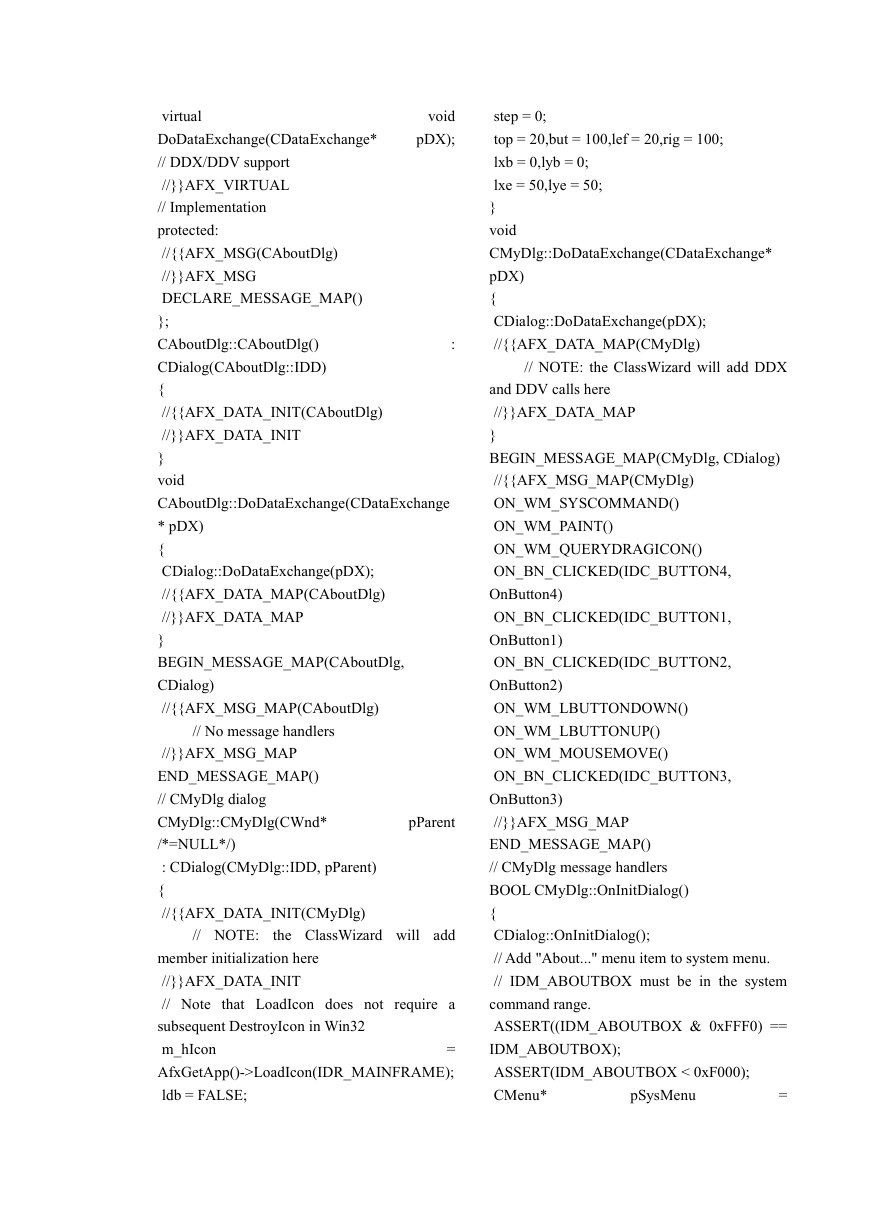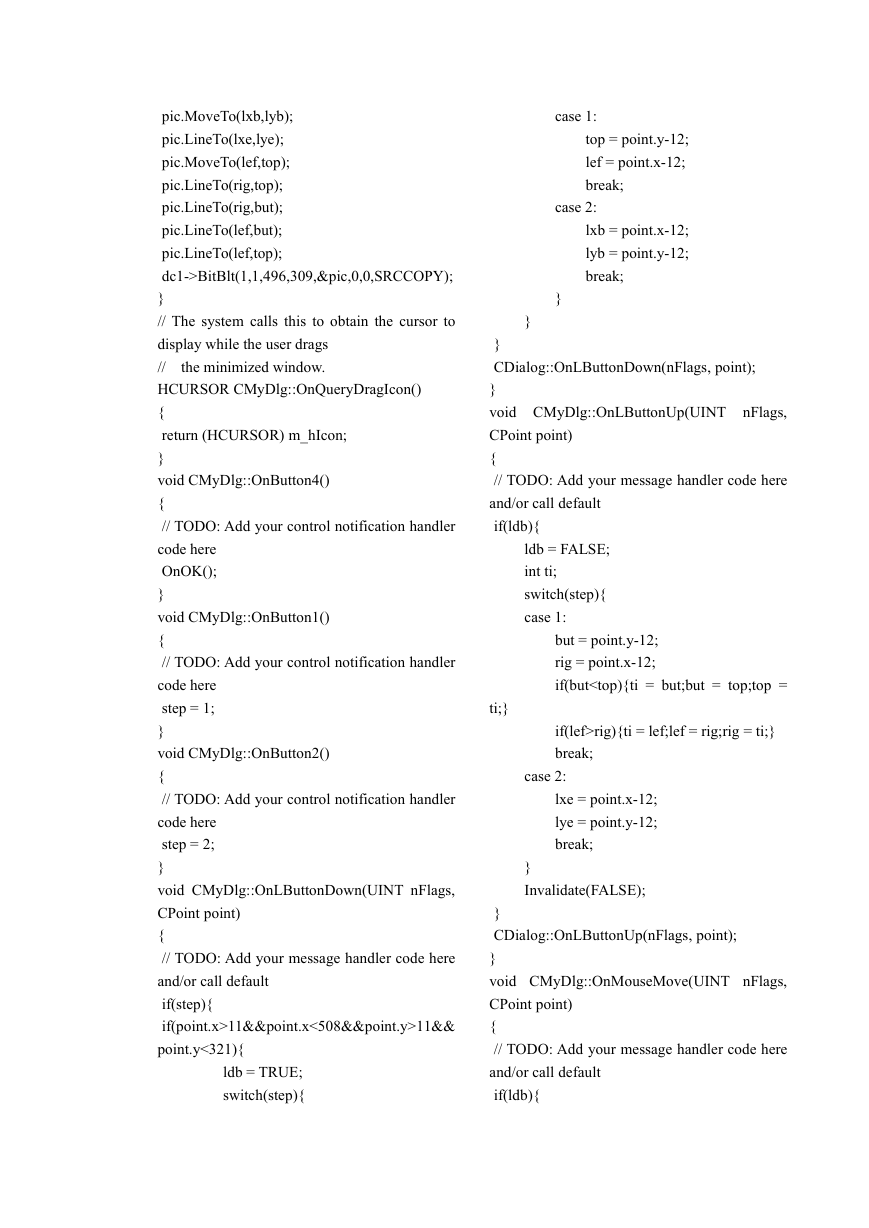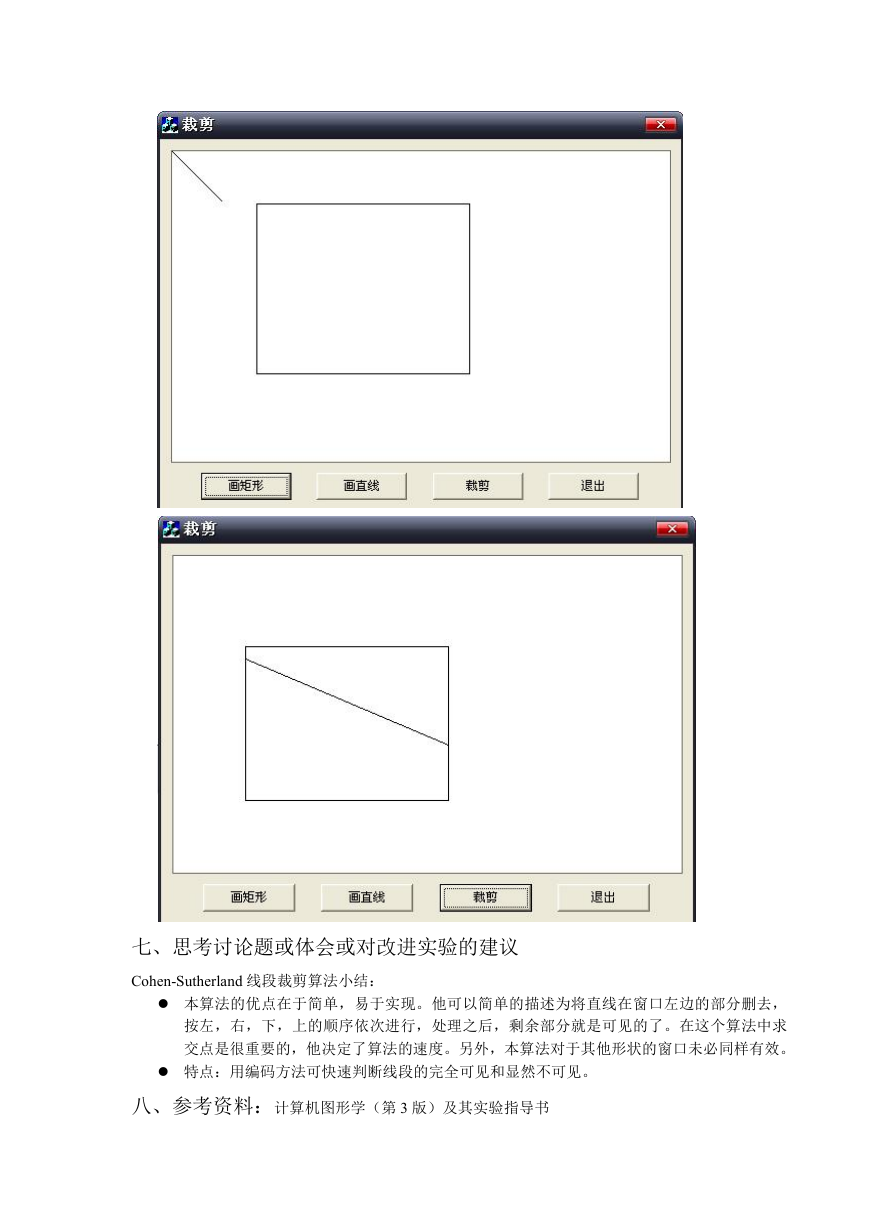南昌大学实验报告
学生姓名: 陈洁
实验类型:□ 验证 □ 综合 □ 设计 □ 创新 实验日期: 08.12.1
一、实验项目名称:线段裁剪
号: 6103106040
学
专业班级: 计算机 062
实验成绩:
二、实验目的:理解和掌握 Cohen-SutherLand 裁剪的原理和算法。
三、实验基本原理:
对于每条线段 P1P2 分为三种情况处理分为三种情况处理:
(1)若 P1P2 完全在窗口内,则显示该线段 P1P2 简称“取”之;
(2)若 P1P2 明显在窗口外,则丢弃该线段,简称“弃”之;
(3)若线段不满足“取”或 “弃”的条件,则在交点处把线段分为两段。其中一段完全在窗口外,可
弃之。然后对另一段重复上述处理。
将区域码的各位从右到左编号,则坐标区域与各位的关系为:
上 下 右 左
X
X
任何位赋值为 1,代表端点落在相应的位置上,否则该位为 0。若端点在剪取矩形内,区域码为 0000。
如果端点落在矩形的左下角,则区域码为 0101。
一旦给定所有的线段端点的区域码,就可以快速判断哪条直线完全在剪取窗口内,哪条直线完全在
窗口外。所以得到一个规律:
X
X
– 若 P1P2 完全在窗口内 code1=0,且 code2=0,则“取”
– 若 P1P2 明显在窗口外 code1&code2≠0,则“弃”
– 在交点处把线段分为两段。其中一段完全在窗口外,可弃之。然后对另一段重复上述处理。
如何判定应该与窗口的哪条边求交呢?
编码中对应位为 1 的边。
计算线段 P1(x1,y1)P2(x2,y2)与窗口边界的交点。
具体算法见书上 p201。
1001
1000
1010
0001
0000
0010
0101
0100
0110
编码
P1
P3
P4
P2
线段裁剪
四、主要仪器设备及耗材:PC 微机;Windows 操作系统;Visual C++ 程序集成环境。
五、实验步骤:
1、理解和掌握 Cohen-SutherLand 裁剪的原理和算法;
2、根据算法编写(或修改)程序裁剪线段;
3、对程序进行编译,纠正程序中可能出现的语法错误;
4、测试程序运行效果:从键盘输入数据,在屏幕上输出,检查输出结果。
六、实验数据及处理结果
编写程序如下:
// 裁剪 Dlg.h:header file
//
#if !defined(AFX_DLG_H__BE852DB5_A0A9
_4DC6_A10F_6D35796C1BDE__INCLUDED
_)
#define
�
AFX_DLG_H__BE852DB5_A0A9_4DC6_A1
0F_6D35796C1BDE__INCLUDED_
#if _MSC_VER > 1000
#pragma once
#endif // _MSC_VER > 1000
// CMyDlg dialog
class CMyDlg : public CDialog
{
// Construction
public:
CMyDlg(CWnd* pParent = NULL);
standard constructor
// Dialog Data
//{{AFX_DATA(CMyDlg)
enum { IDD = IDD_MY_DIALOG };
//
// NOTE: the ClassWizard will add data
function
void
//
members here
//}}AFX_DATA
// ClassWizard generated virtual
overrides
//{{AFX_VIRTUAL(CMyDlg)
protected:
virtual
DoDataExchange(CDataExchange* pDX);
DDX/DDV support
//}}AFX_VIRTUAL
// Implementation
protected:
int code(int x,int y);
HICON m_hIcon;
CDC pic;//图片
int top,but;//
int lef,rig;//矩形
int lxb,lyb;
int lxe,lye;//直线坐标
BOOL ldb;//左键是否按下。
int step;//步骤
// Generated message map functions
//{{AFX_MSG(CMyDlg)
virtual BOOL OnInitDialog();
afx_msg void OnSysCommand(UINT nID,
LPARAM lParam);
afx_msg void OnPaint();
afx_msg HCURSOR OnQueryDragIcon();
afx_msg void OnButton4();
afx_msg void OnButton1();
afx_msg void OnButton2();
afx_msg void OnLButtonDown(UINT nFlags,
CPoint point);
afx_msg void OnLButtonUp(UINT nFlags,
CPoint point);
afx_msg void OnMouseMove(UINT nFlags,
CPoint point);
afx_msg void OnButton3();
//}}AFX_MSG
DECLARE_MESSAGE_MAP()
};
//{{AFX_INSERT_LOCATION}}
// Microsoft Visual C++ will insert additional
declarations immediately before the previous
line.
#endif
// !defined(AFX_DLG_H__BE852DB5_A0A9_
4DC6_A10F_6D35796C1BDE__INCLUDED_
)
// 裁剪 Dlg.cpp : implementation file
//
#include "stdafx.h"
#include "裁剪.h"
#include "裁剪 Dlg.h"
#ifdef _DEBUG
#define new DEBUG_NEW
#undef THIS_FILE
static char THIS_FILE[] = __FILE__;
#endif
// CAboutDlg dialog used for App About
class CAboutDlg : public CDialog
{
public:
CAboutDlg();
// Dialog Data
//{{AFX_DATA(CAboutDlg)
enum { IDD = IDD_ABOUTBOX };
//}}AFX_DATA
// ClassWizard generated virtual
overrides
//{{AFX_VIRTUAL(CAboutDlg)
protected:
function
�
:
void
pDX);
virtual
DoDataExchange(CDataExchange*
// DDX/DDV support
//}}AFX_VIRTUAL
// Implementation
protected:
//{{AFX_MSG(CAboutDlg)
//}}AFX_MSG
DECLARE_MESSAGE_MAP()
};
CAboutDlg::CAboutDlg()
CDialog(CAboutDlg::IDD)
{
//{{AFX_DATA_INIT(CAboutDlg)
//}}AFX_DATA_INIT
}
void
CAboutDlg::DoDataExchange(CDataExchange
* pDX)
{
CDialog::DoDataExchange(pDX);
//{{AFX_DATA_MAP(CAboutDlg)
//}}AFX_DATA_MAP
}
BEGIN_MESSAGE_MAP(CAboutDlg,
CDialog)
//{{AFX_MSG_MAP(CAboutDlg)
// No message handlers
//}}AFX_MSG_MAP
END_MESSAGE_MAP()
// CMyDlg dialog
CMyDlg::CMyDlg(CWnd*
/*=NULL*/)
: CDialog(CMyDlg::IDD, pParent)
{
//{{AFX_DATA_INIT(CMyDlg)
pParent
// NOTE:
the ClassWizard will
add
member initialization here
//}}AFX_DATA_INIT
// Note that LoadIcon does not
subsequent DestroyIcon in Win32
=
m_hIcon
AfxGetApp()->LoadIcon(IDR_MAINFRAME);
ldb = FALSE;
require a
step = 0;
top = 20,but = 100,lef = 20,rig = 100;
lxb = 0,lyb = 0;
lxe = 50,lye = 50;
}
void
CMyDlg::DoDataExchange(CDataExchange*
pDX)
{
CDialog::DoDataExchange(pDX);
//{{AFX_DATA_MAP(CMyDlg)
// NOTE: the ClassWizard will add DDX
and DDV calls here
//}}AFX_DATA_MAP
}
BEGIN_MESSAGE_MAP(CMyDlg, CDialog)
//{{AFX_MSG_MAP(CMyDlg)
ON_WM_SYSCOMMAND()
ON_WM_PAINT()
ON_WM_QUERYDRAGICON()
ON_BN_CLICKED(IDC_BUTTON4,
OnButton4)
ON_BN_CLICKED(IDC_BUTTON1,
OnButton1)
ON_BN_CLICKED(IDC_BUTTON2,
OnButton2)
ON_WM_LBUTTONDOWN()
ON_WM_LBUTTONUP()
ON_WM_MOUSEMOVE()
ON_BN_CLICKED(IDC_BUTTON3,
OnButton3)
//}}AFX_MSG_MAP
END_MESSAGE_MAP()
// CMyDlg message handlers
BOOL CMyDlg::OnInitDialog()
{
CDialog::OnInitDialog();
// Add "About..." menu item to system menu.
// IDM_ABOUTBOX must be in the system
command range.
ASSERT((IDM_ABOUTBOX & 0xFFF0) ==
IDM_ABOUTBOX);
ASSERT(IDM_ABOUTBOX < 0xF000);
CMenu*
pSysMenu
=
�
GetSystemMenu(FALSE);
if (pSysMenu != NULL)
{
CString strAboutMenu;
strAboutMenu.LoadString(IDS_ABOUTBOX)
if (!strAboutMenu.IsEmpty())
{
pSysMenu->AppendMenu(MF_SEPARATOR)
;
;
pSysMenu->AppendMenu(MF_STRING,
IDM_ABOUTBOX, strAboutMenu);
}
//
Set
// Set small
}
// Set the icon for this dialog. The framework
does this automatically
// when the application's main window is not
a dialog
SetIcon(m_hIcon, TRUE);
big icon
SetIcon(m_hIcon, FALSE);
icon
// TODO: Add extra initialization here
CPaintDC dc(this);
pic.CreateCompatibleDC(&dc);
CBitmap * bp1,*obp1;
bp1 = new CBitmap;
bp1->LoadBitmap(IDB_B);
obp1 = pic.SelectObject(bp1);
obp1->DeleteObject();
return TRUE;
the focus to a control
}
void CMyDlg::OnSysCommand(UINT nID,
LPARAM lParam)
{
if ((nID & 0xFFF0) == IDM_ABOUTBOX)
{
// return TRUE unless you set
CAboutDlg dlgAbout;
dlgAbout.DoModal();
}
else
{
CDialog::OnSysCommand(nID, lParam);
to draw the icon.
For MFC applications
this is automatically done for you by the
}
}
// If you add a minimize button to your dialog,
you will need the code below
//
using the document/view model,
//
framework.
void CMyDlg::OnPaint()
{
CPaintDC dc(this);
painting
if (IsIconic())
{
SendMessage(WM_ICONERASEBKGND,
(WPARAM) dc.GetSafeHdc(), 0);
// device
context
for
// Center icon in client rectangle
int
cxIcon
GetSystemMetrics(SM_CXICON);
int
cyIcon
GetSystemMetrics(SM_CYICON);
=
=
CRect rect;
GetClientRect(&rect);
int x = (rect.Width() - cxIcon + 1) / 2;
int y = (rect.Height() - cyIcon + 1) / 2;
// Draw the icon
dc.DrawIcon(x, y, m_hIcon);
}
else
{
CDialog::OnPaint();
}
CDC mdc;
CBitmap bmp,*bp;
bmp.LoadBitmap(IDB_B);
mdc.CreateCompatibleDC(GetDC());
bp = mdc.SelectObject(&bmp);
pic.BitBlt(0,0,500,320,&mdc,0,0,SRCCOPY);
mdc.SelectObject(bp);
CDC * dc1;
CWnd * wd1;
wd1 = this->GetDlgItem(IDC_S);
dc1 = wd1->GetDC();
�
pic.MoveTo(lxb,lyb);
pic.LineTo(lxe,lye);
pic.MoveTo(lef,top);
pic.LineTo(rig,top);
pic.LineTo(rig,but);
pic.LineTo(lef,but);
pic.LineTo(lef,top);
dc1->BitBlt(1,1,496,309,&pic,0,0,SRCCOPY);
}
// The system calls this to obtain the cursor to
display while the user drags
//
the minimized window.
HCURSOR CMyDlg::OnQueryDragIcon()
{
return (HCURSOR) m_hIcon;
}
void CMyDlg::OnButton4()
{
// TODO: Add your control notification handler
code here
OnOK();
}
void CMyDlg::OnButton1()
{
// TODO: Add your control notification handler
code here
step = 1;
}
void CMyDlg::OnButton2()
{
// TODO: Add your control notification handler
code here
step = 2;
}
void CMyDlg::OnLButtonDown(UINT nFlags,
CPoint point)
{
// TODO: Add your message handler code here
and/or call default
if(step){
if(point.x>11&&point.x<508&&point.y>11&&
point.y<321){
ldb = TRUE;
switch(step){
case 1:
top = point.y-12;
lef = point.x-12;
break;
case 2:
lxb = point.x-12;
lyb = point.y-12;
break;
}
}
}
CDialog::OnLButtonDown(nFlags, point);
}
void CMyDlg::OnLButtonUp(UINT nFlags,
CPoint point)
{
// TODO: Add your message handler code here
and/or call default
if(ldb){
ldb = FALSE;
int ti;
switch(step){
case 1:
but = point.y-12;
rig = point.x-12;
if(butrig){ti = lef;lef = rig;rig = ti;}
break;
ti;}
case 2:
lxe = point.x-12;
lye = point.y-12;
break;
}
Invalidate(FALSE);
}
CDialog::OnLButtonUp(nFlags, point);
}
void CMyDlg::OnMouseMove(UINT nFlags,
CPoint point)
{
// TODO: Add your message handler code here
and/or call default
if(ldb){
�
switch(step){
case 1:
but = point.y-12;
rig = point.x-12;
break;
case 2:
lxe = point.x-12;
lye = point.y-12;
break;
}
Invalidate(FALSE);
}
CDialog::OnMouseMove(nFlags, point);
}
#define LEFT 1
#define RIGHT 2
#define BOTTOM 4
#define TOP 8
int CMyDlg::code(int x,int y){//编码函数
int c = 0;
if(x
rig)
c = c|RIGHT;
if(y>but)
c = c|BOTTOM;
else if(y七、思考讨论题或体会或对改进实验的建议
Cohen-Sutherland 线段裁剪算法小结:
本算法的优点在于简单,易于实现。他可以简单的描述为将直线在窗口左边的部分删去,
按左,右,下,上的顺序依次进行,处理之后,剩余部分就是可见的了。在这个算法中求
交点是很重要的,他决定了算法的速度。另外,本算法对于其他形状的窗口未必同样有效。
特点:用编码方法可快速判断线段的完全可见和显然不可见。
八、参考资料:计算机图形学(第 3 版)及其实验指导书
�














 2023年江西萍乡中考道德与法治真题及答案.doc
2023年江西萍乡中考道德与法治真题及答案.doc 2012年重庆南川中考生物真题及答案.doc
2012年重庆南川中考生物真题及答案.doc 2013年江西师范大学地理学综合及文艺理论基础考研真题.doc
2013年江西师范大学地理学综合及文艺理论基础考研真题.doc 2020年四川甘孜小升初语文真题及答案I卷.doc
2020年四川甘孜小升初语文真题及答案I卷.doc 2020年注册岩土工程师专业基础考试真题及答案.doc
2020年注册岩土工程师专业基础考试真题及答案.doc 2023-2024学年福建省厦门市九年级上学期数学月考试题及答案.doc
2023-2024学年福建省厦门市九年级上学期数学月考试题及答案.doc 2021-2022学年辽宁省沈阳市大东区九年级上学期语文期末试题及答案.doc
2021-2022学年辽宁省沈阳市大东区九年级上学期语文期末试题及答案.doc 2022-2023学年北京东城区初三第一学期物理期末试卷及答案.doc
2022-2023学年北京东城区初三第一学期物理期末试卷及答案.doc 2018上半年江西教师资格初中地理学科知识与教学能力真题及答案.doc
2018上半年江西教师资格初中地理学科知识与教学能力真题及答案.doc 2012年河北国家公务员申论考试真题及答案-省级.doc
2012年河北国家公务员申论考试真题及答案-省级.doc 2020-2021学年江苏省扬州市江都区邵樊片九年级上学期数学第一次质量检测试题及答案.doc
2020-2021学年江苏省扬州市江都区邵樊片九年级上学期数学第一次质量检测试题及答案.doc 2022下半年黑龙江教师资格证中学综合素质真题及答案.doc
2022下半年黑龙江教师资格证中学综合素质真题及答案.doc